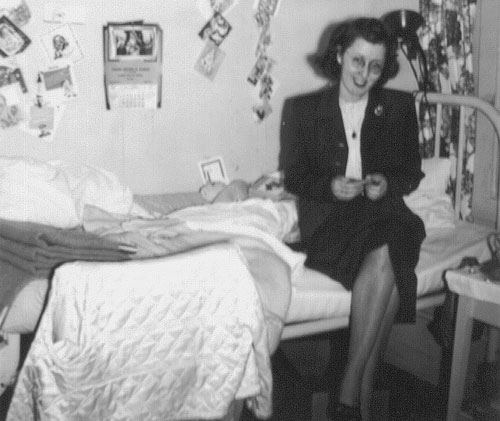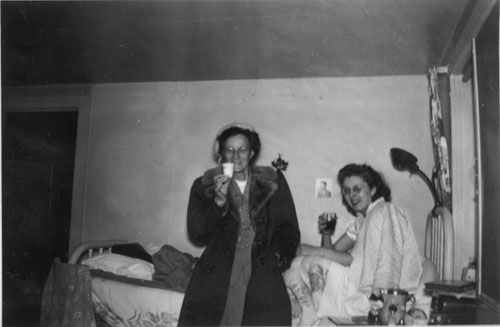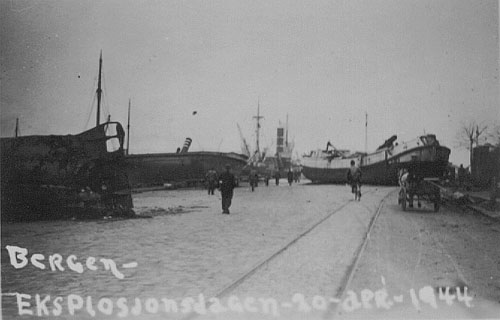 The Erwicks of Ketchikan By DAVE KIFFER March 21, 2006
Part of their legacy is the town of Petersburg and Ketchikan's historic First Lutheran Church building. The story of the Erwick family in Ketchikan in the first half of the 20th Century is a fairly typical one, but with some interesting twists. The migration was part of a larger migration that saw thousands of single men and families leave Norway for a better economic or social life in the United States. According to a history of Norwegian migration to the United States on the Minnesota State University-Makato website, many of the immigrants came because of cheap farming land in the US, but there were also social reasons to leave Norway.  Photograph courtesy Mike & Marta Hart
Because the United States did not have an official caste system or such strict protocol for interactions among people, many Norwegians looked at the U.S. as an appealing place to live, the website also notes Another factor, one that would be very important to the Erwick family in Ketchikan, was that everyone (at least all the males up to 1920) in America could vote and that anyone could run for office. Henry Erwick came to Ketchikan from Norway in 1903 and opened a marine hardware store that was first located on city dock up until the early 1920s, according to information from the Tongass Historical Museum. By 1926, it had relocated to the Newtown area north of the tunnel, according to a story in the Ketchikan Chronicle which indicated that the Ryus Drug store had opened a "branch store in the Erwick Building in Newtown." Erwick's store and home was at 718 Water Street. By 1935, Erwick was calling his business "The Fisherman Store" and was well established. Like many fishing related businesses, he extended credit to the his customers over the long winter, allowing the fishermen to "settle up" when then started landing fish again in the spring and summer. In addition to his business, Henry Erwick served on the Ketchikan City Council for 19 years. According to reports in the Ketchikan Chronicle, Erwick was among the members of the council that favored keeping the Creek Street red light district.open. "He argued that as long as Creek Street remained open that 'our young daughters would remain safe,' " writes family historian Mike Hart, who is the son of Erwick's great-niece, Jennie Erwick. Henry Erwick died in 1957. "He died while attempting to wind the Seth Thomas marine ship clock that had been in his store since 1904. He fell from the ladder and landed on a large key ring that he kept on his belthe contracted pneumonia while lying on the cold floor and died a short time later."  Photograph courtesy Mike & Marta Hart
Jennie Erwick also had an interesting local history. After being born in Ketchikan, she ended up spending much of her youth back in Norway during World War II. Jennie Erwick was born in Ketchikan in 1931. Her parents were Johan and Johanna (Johannessen) Erwick. Johan was born in Nordfjord in 1900. "Johan's last name originally was also Johannessen, but he changed it Erwick at an early age because the family farm were he grew up in Nordfjord was in an area called Erwick and it was tradition to take on the 'farm name' that was native to the area," Mike Hart wrote in his family history. Johan migrated to Ketchikan in 1920s to work for his uncle Henry Erwick. He went back to Norway a few years later and married Johanna, who had been born in Bergen in 1898. They returned to Ketchikan and Johan owned the fishing troller Gene. He also worked at Henry Erwick's store and listed that as his occupation on Jennie's birth certificate. Mike Hart also has a copy of one of his mother's piano books which listed 1436 Millar Street as the family address. But when Jennie was four years old, she and her mother returned to Norway. Johanna's mother had became ill and Johanna, who was a trained nurse, went back to Bergen to care for her. Martha Johannessen died shortly after her daughter and granddaughter arrived. But the Germans invaded Norway before they could return. Jennie and her mother were stranded in Norway for the duration of the war. "During the war she endured both German and Allied bombings, harassment by the SS and lived under the constant threat of being arrested for being an American citizen," Hart writes. "Malnutrition was a common problem during the war. Much of her subsistence was on 'sawdust bread,' literally compressed sawdust and potatoes." Hart writes that his mother often talked about "potatoes for breakfast, potatoes for lunch, potatoes for dinner, stewed potatoes, fried potatoes, potato soup." Despite the monotonous wartime diet, Hart says, his mother loved to eat potatoes her entire life. "Many of her stories from the war were about food," Hart writes. "When she and Johanna managed to visit paternal relatives in Nordfjord, they tried to take some eggs, butter and cheese from the farm back to Bergen with them. As the boat was approaching the dock, they could see that the SS was there to confiscate anything they wanted. Knowing that the fresh farm goods would be high on the list of SS desirables, they threw it overboard into the water rather than let the SS take it." Jennie also told Hart that it wasn't unusual to wait in line all day for food, only to have the SS close the line and confiscate whatever was being disbursed to the people. Jennie Erwick went to elementary, middle, and business school under the German occupation. "In school she new of, or was friends with, people in the underground," Hart writes. "She recounted how many of them simply disappeared. She often said she wanted to join the underground but her mother wouldn't let her." The dangers of daily life in those years also stayed with her for the rest of her life, "While walking home from school one day she was stopped by an SS officer who asked her to translate Norwegian to German for him," Hart writes. " She refused and began to walk away while the officer was shouting orders at her. She got a certain distance from the SS when she heard shots. At that point she ran home. She never knew for sure whether the shots were directed at her or not, but assumed that they were as that was how the SS usually dealt with anyone who denied an order." Hart writes that one of his mother's most vivid memories was a huge wartime explosion in Bergen harbor. His mother said the explosion happened on "Hitler's birthday." "She recounted that she was on a sidewalk and saw a man on the other side of the street," Hart writes. "When the explosion hit she was knocked to the ground and the man vanished. Carried away by the force of the bomb I assume. She also told of the gruesome effects those close to the blast experienced, one person literally carrying their eye balls in their hands."  Photograph courtesy Mike & Marta Hart
After the war, Jennie Erwick and her mother returned to Ketchikan, but not for long. Jennie apparently contracted turberculosis while in Norway. Despite her illness, she attempted to complete her education at Ketchikan High School, but had to leave in 1948 when her illness worsened. She finished her high school requirements by correspondence "According to her year book, she entered Kayhi from the Business High School in Bergen, was in the Student Body Association, the Science Club, the Girls Athletic Association, the drill team, the girls glee club and mixed chorus," Hart writes. "She graduated in 1950, two years late due to her illness." Hart writes that Jennie had surgery in Seattle. "It was there that she had her right lung removed and seven half-ribs after which she spent two years at the Laurel Beach Sanatorium in West Seattle," Hart writes. "At the time of the surgery they were supposed to remove only part of her right lung. By the end of the surgery the entire right lung had been removed and scar tissue from the disease remained on the left. Doctor's told her that she would probably not survive, to which she replied 'the hell I won't.'" At Laurel Beach, Erwick was also pleased to see several other young women from Ketchikan, including my mother, Merta (Smith) Kiffer. "During her recovery in the sanatorium she underwent intensive physical therapy which was painful and tedious," Hart writes. "Most patients who underwent such rehabilitation wound up severely crippled and disabledbut she was determined not to be impaired in any way." Also during this time, her parents divorced and Johanna moved to West Seattle. In 1952, she was released from Laurel Beach and moved in with her mother in West Seattle. She married Anthony Thompson in 1953 and they settled in Seattle. They eventually divorced and she married Tom Hart in 1974. Johann Erwick moved to the Seattle area, remarried, and died in 1971. Eventually, Johanna Erwick returned to Ketchikan, where she died in 1981. Jennie Erwick remained in the Seattle area and died in 1993.
Contact Dave at dave@sitnews.us Dave Kiffer ©2006
|